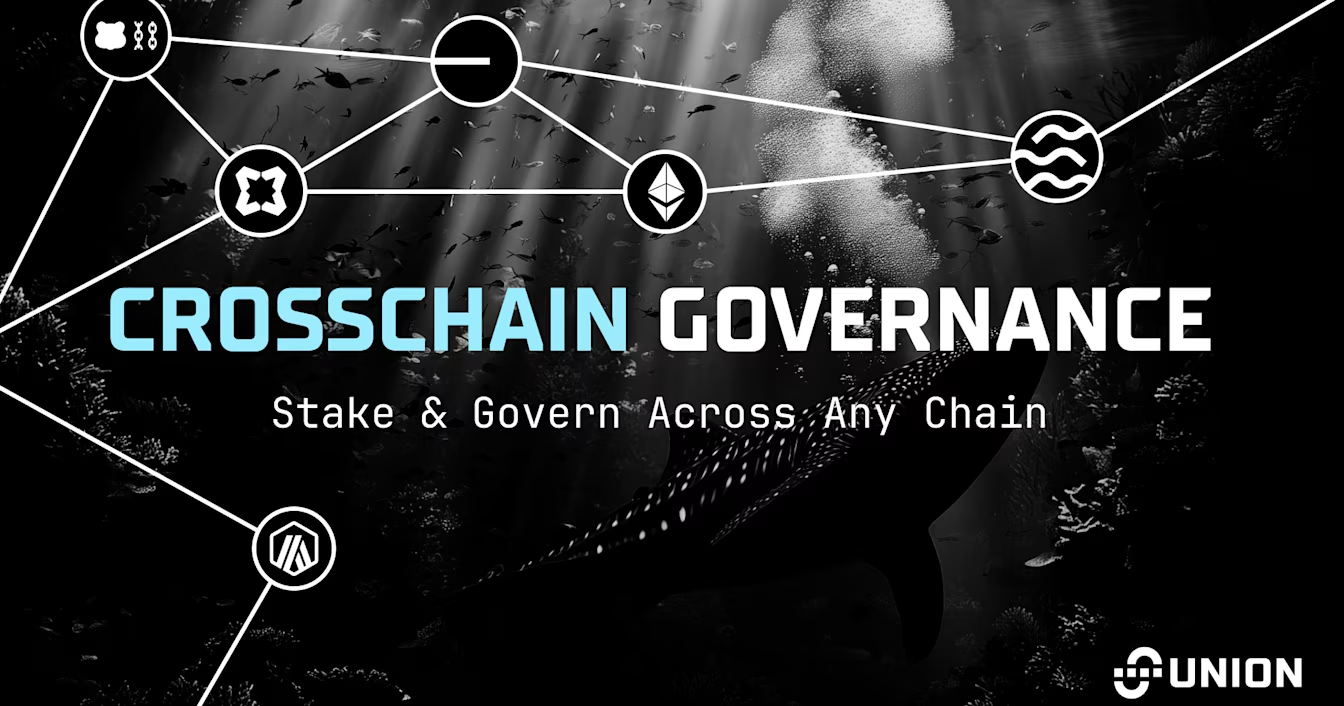When Union launches its public mainnet, it will go live with a Proof of Stake governance system to manage critical decision making for the ecosystem. The network will be based on the Cosmos framework, yet as a project integrating with every ecosystem, Union will do things differently.
Union is building toward a truly crosschain future, so it wouldn’t make sense to confine governance to a single chain. That’s why it won’t be.
Introducing Crosschain Governance, a custom module that enables Union tokens on other chains to be staked and delegated to the Union chain without bridging. This module will expand access to and support for Union staking and governance—and other Cosmos-based blockchains will be able to utilize it in the future as well.
Here’s everything you need to know about one of the last major pieces before mainnet.
What is the Crosschain Governance Module?
While some think of Union as a bridging protocol, it’s much more than that—it’s a general message passing interoperability protocol, which means Union facilitates any message sent between chains.
This is a key difference between Union IBC and legacy IBC frameworks. IBC was created for asset transfers, and fungible token transfers specifically. This is still true of other IBC frameworks in use today, which is why modifications have to be made to transfer NFTs via IBC, or more complex transfer options.
Light client-based, ZK-powered Union IBC is limitless. It can transfer any message across chains. That opens up new possibilities, such as allowing users to stake to a chain’s governance module from connected chains without having to transfer their tokens.
That’s Crosschain Governance. Starting with EVM, Union token holders will be able to stake to Union governance directly from Ethereum, using familiar EVM wallets and with full access to Ethereum protocols.
Why Union is Building Crosschain Governance
Union is crosschain by design. The Union blockchain is an integral part of the protocol’s architecture; it’s where the state of all connected chains is stored, which allows the Union light clients deployed on connected chains to access this state quickly and efficiently.
As the token of a crosschain protocol, the Union token is intended to be truly crosschain as well. But that won't be the case if key Union activities, such as staking and governance, can only take place on a single chain.
Union is also a systems chain without a DeFi ecosystem. By making staking and governance crosschain, it unlocks considerable DeFi possibilities, such as secondary markets for staked positions, using staked positions as collateral, and instant composability with major EVM DeFi protocols by making it native to the largest DeFi ecosystems in the world. This lowers liquidity fragmentation, which allows for a better user experience for those using the Union token.
Existing EVM wallet providers, custody solutions, and other token-related protocols will also work with the Union token, in addition to Cosmos infrastructure. This will expand to other ecosystems as more governance hubs are added, making Union governance and staking a scalable, crosschain experience that’s accessible to all.
How Crosschain Governance Works
Say a user wants to stake their Union tokens on Ethereum to the Union governance module and receive token emissions. With legacy IBC, the user would need to bridge their tokens to the Union chain and then stake them. This requires a number of steps—create a Cosmos wallet, manually stake using potentially unfamiliar tooling, and remain locked into the Cosmos ecosystem for the duration.
This will still be an option with Union, for those who wish to do it this way. But for those unfamiliar with Cosmos, requiring that method could cause them to opt out of participating entirely.
With Crosschain Governance, it will be easy for all users to get involved. Here’s how it works:
When a user chooses to stake their Union tokens from Ethereum, a message will be sent to the Union blockchain. This will create a stake account for the user with the corresponding amount of Union tokens, which will be delegated to the validator of the user's choosing. The contract will track each individual staking position, with all necessary information visible in the user’s EVM wallet.
Unstaking is a similar process. When the user chooses to unstake, they must unstake their entire position (currently—this can be changed via Union governance), i.e. their original stake and any token emissions they’ve received. A single message will be sent to the Union chain, which will begin the unstaking process.
Finally, when the unstaking period is complete, the user can perform a final transaction to withdraw their Union tokens on Ethereum.
That’s how it will work for Union—and other protocols will be able to use Crosschain Governance by Union as well. By designating their token as the governance token for their chain, the same process will apply to Crosschain Governance transactions from connected networks to their blockchain.
For a technical deep dive, keep an eye on Union R&D—the full research report will be available soon.
The Future of Crosschain Governance
In its initial release, Crosschain Governance will support staking, unstaking, and rewards withdrawals from Ethereum mainnet, with governance hubs on other EVM chains to follow. A user’s Union tokens will be delegated to the validator of their choosing, and the validator will vote on behalf of the user. Direct voting by users will only be available to those who stake directly on the Union chain. Crosschain voting will be added in a future version.
Crosschain Governance will also be made available for other Cosmos SDK chains to use, which positions Union as foundational infrastructure for crosschain governance across the broader Cosmos ecosystem.
But first, the initial version of Crosschain Governance will be released alongside Union’s public mainnet s0____0n. zkgm.
